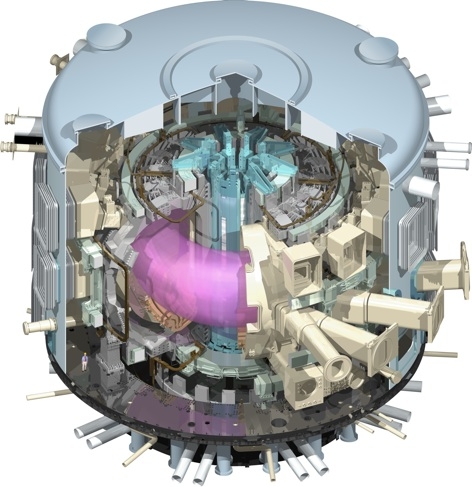The rig, developed at the Max Planck Institute for Plasma Physics (IPP) near Munich, will aid the creation of a device that will heat the plasma in ITER, the fusion reactor currently taking shape in southern France, to temperatures hotter than the surface of the sun.
The ELISE (Extraction from a Large Ion Source) rig will test neutral particle injectors — devices that shoot fast, uncharged hydrogen atoms into fusion plasma. As they collide with particles in the plasma, they slow down, transfer their energy to the plasma, and cause its temperature to rise.
Neutral particle injection is one of the main ways that plasma in fusion reactors is heated: it has to reach a temperature of more than 100 million Kelvin in order for the charged hydrogen ions in the plasma to overcome electrostatic repulsion forces and come close enough together for fusion to occur.
ITER will be equipped with two neutral beam injectors, but as it is eight times the volume of the current largest fusion reactor — the UK-based JET (Joint European Torus) — the injectors will have to be larger and more powerful, pumping 16.5MW of heating power into 800m3 of plasma. Current injectors are ‘about the size of a dinner plate’, IPP said in a statement: ITER’s will have to be ‘about the size of a door’.

Neutral beam injectors work by accelerating charged hydrogen ions using magnetic fields, then rendering them neutral just before they enter the plasma. For ITER, the injectors will have to accelerate particles to 9,000km/sec — about four times faster than has previously been achieved — so that they have enough energy to penetrate to the centre of the plasma.
ELISE, which has been under construction at Garching for the past three years, will now test a new type of ion source for the injectors. Previous fusion experiments have used positively charged hydrogen ions, which are relatively stable, but the faster a positive ion travels, the harder it is to neutralise.
ITER, therefore, will have to use negative ions, which are easier to neutralise but far less stable and more difficult to handle. The extra electron that gives the particle its negative charge is bound to the atom very loosely, and if it falls off, the ion can no longer be accelerated.
IPP developed a negative-particle ion source for neutral beam injection in 2007, and is now refining it for use in ITER. The source to be tested in ELISE is about half the size as the ones that will be needed, and testing will take around two years.
Further development will then be handled by another institution, the Italian National Agency for New Technologies, Energy and Sustainable Economic Development, near Padua, before the injectors are installed at ITER in time for its scheduled start-up in 2020.
For more information on ITER, see our recent readers’ Q&A feature on nuclear fusion.




Swiss geoengineering start-up targets methane removal
No mention whatsoever about the effect of increased methane levels/iron chloride in the ocean on the pH and chemical properties of the ocean - are we...